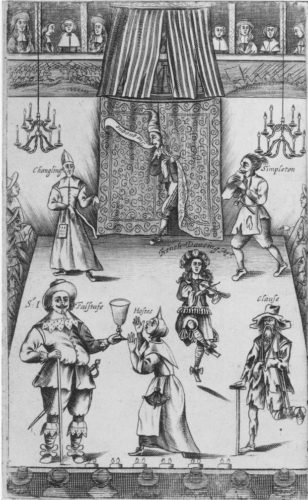In this frontispiece to Kirkman’s collection of drolls – one of the earliest illustrations of the interior of a theatre - the character emerging from behind the curtain or arras speaks the catchphrase ‘to quoque’ (Latin for ‘you too’ or ‘the same to you’) from John Cooke’s Greene’s Tu Quoque (also known as The City Gallant), a popular comedy from 1611. The contents of The Wits were described by Kirkman as ‘selected pieces of drollery, digested into scenes by way of dialogue’, or ‘pieces of plays’ popular in the Commonwealth between 1642 and 1662, when the theatres were largely closed. During this period, as Kirkman tells us, plays had to be enjoyed piecemeal, or ‘by stealth...under the pretence of Rope-dancing, or the like’, making theatrical performance a form of clandestine knowledge. The illustration is from 1662, not long after the theatres fully re-opened with the restoration of the monarchy. The ornate, conspicuous, half-opened curtains preserve and recreate the sense of alluring secrecy that had become associated with the theatre itself by this time.
What other popular plays are evoked in Kirkman’s illustration of well-known characters from the stage?











